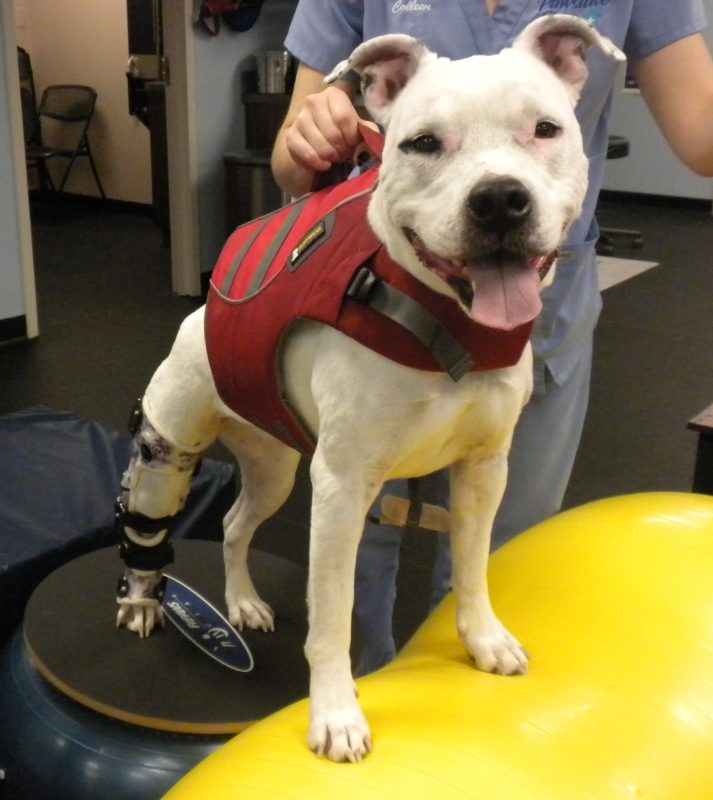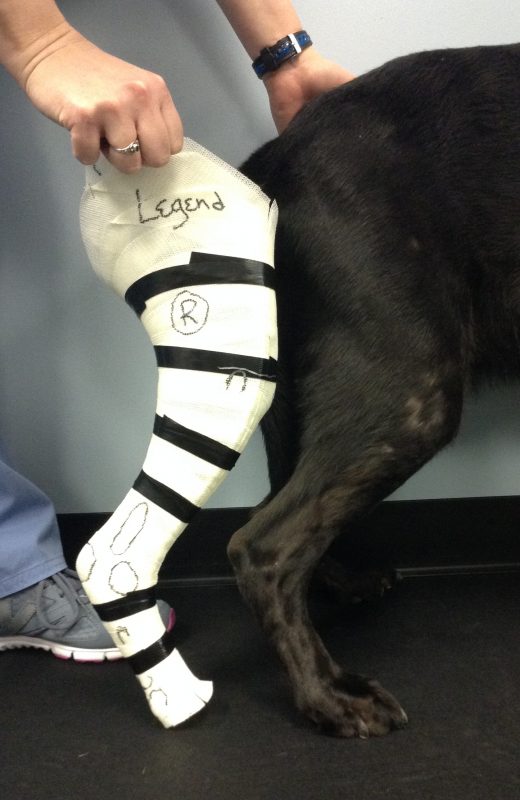Stifle Orthotics – Alternative Options to CCL Surgery
by Colleen Lum, LVT, CCRA
We like having options don’t we? And nowadays we are looking for alternative options not only for ourselves, but for our furry family members as well. However, even though there may be an alternative, it does not mean that it is the best choice for everyone. Today we are going to discuss stifle orthotics, its pros and cons, and what to expect when pursuing this route!
How does a stifle orthotic work?
When our dogs tear the cranial cruciate ligament in their stifle (knee) it creates instability and pain because the lower half of the stifle slides forward whenever the dog bears weight on the leg. A stifle orthosis, when fitted properly, prevents this movement by stabilizing the joint externally, rather than stabilizing internally such as with surgery.
Why choose a stifle orthosis?
The most common reason why owners are interested in a stifle orthosis is to avoid the anesthetic risk that accompanies surgery. Whether your dog is a 15 year old pointer with chronic kidney disease or a 2 year old beagle with a heart murmur, sometimes your surgeon may want to avoid surgery because of the increased risk anesthesia has on these types of patients. However, before pursuing this path, there are a few things you should know first.
Facts About Stifle Orthotics
- They are NOT a cheaper alternative to surgery, expect to pay at least $1500 for a package, which includes:
- initial evaluation with Dr. Kern
- creating a cast of the limb to send to the manufacturer (used to create the custom device)
- shipping/handling of the cast and return of the finished device
- the orthosis device
- the fitting visit
- A minimum of three follow up visits after the fitting (and likely many more visits after).
- It is not a “quick fix” or “throw it on and forget it” solution. Just like needing recovery time after surgery, there is adjustment time after fitting the device. Depending on how much the owner is able to work with their dog at home in acclimating to the orthotic device, it may take several months to adjust to it, use it and get back to full normal function.
- Wear schedule and Maintenance:
- Initially we want our patients to be wearing it for ~1-2 hours on with 2 hours of break time in between throughout the first week. Gradually, the wear time will be increased to full daytime use, as long as they are tolerating it.
- After the initial adjustment period, the device is usually worn all day for about 1-2 years. This gives the stifle time to form strong scar tissue that will then stabilize the joint. However at that point, we still recommend that they wear the device if engaging in intense activity as an athletic support.
- Every 1-2 years, refurbishment of the orthosis may be necessary to ensure that it continues to be effective and comfortable.
Reasons Why Your Dog May Not Be a Candidate
- If the meniscus is torn – the orthosis stabilizes the stifle from sliding forward, it does NOT prevent the meniscus from being aggravated by movement of the joint. Think of a hangnail constantly being rubbed against while you are trying to grip your pen. OUCH! In this case, surgery is the only way to remove this source of constant pain and irritation.
- Sensitive skin – some patients with very thin hair coats and/or severe skin allergies/conditions may not be candidates because they may be sensitive to the pressure caused by the device being in contact with the patient for lengthy periods of time.
- Overweight patients – patients carrying extra weight may have a belly that hangs down and may push an orthotic device down also, which would be uncomfortable for the pet and no allow the device to function properly.
- Short, stubby legs – some breeds have a conformation that makes it difficult to impossible for an orthosis to fit properly. For example, some beagles do not have a well-defined flank space, making it difficult for an orthosis to extend high enough onto the thigh and therefore the device cannot be positioned correctly over the stifle joint.
- Behavioral conflicts/Patient personality – sometimes the patient’s behavior (aggressive, uncooperative, hypersensitive, etc.), despite being a candidate otherwise, may prevent us from being able to move forward with an orthosis.
- Young, healthy and active – if your dog is very active and otherwise healthy enough to undergo surgery, Dr. Kern may recommend pursuing that route in lieu of an orthotic device. Realistically, surgery is the fasted way to stabilize the joint and then we can assist with post-operative rehabilitation to help your pet recover quicker and also provide an outlet for his/her pent up energy during this time of activity restriction. By stabilizing the joint faster with surgery, it also may result in less osteoarthritis in the long term.
So now that you have a little more insight, you think this would be a good alternative for your pet. What is the next step?
What to Expect When Choosing the Orthotic Route
- Initial examination – your first consult with Dr. Kern, at which time she will perform a very thorough evaluation of your dog and will gather media to send to the manufacturer so they can determine if he/she is a candidate.
- Casting visit – we will cast your dog’s hind limb, while they are awake and weight bearing, to create an accurate representation so the manufacturer can design the custom made device.
- Fitting visit –after we receive the device, we will schedule a fitting visit so that we can determine that the device fits properly. Additionally your dog needs to acclimate to it initially and you need to be confident with putting it on and taking it off. We also discuss general care/maintenance and how to gradually increase the duration of time that your dog wears the device. Because as we know, when we wear new shoes for a long duration without breaking them in, we get blisters.
- 3 Orthotic Follow Up Visits – at these visits, we assess your dog’s acclimation to the device, the fit as they grow accustomed to moving in it, and give you exercises to do while they are wearing it to improve the use of the limb now that the joint is stable.
NOTE: 9 times out of 10, we recommend that you return for more visits if your dog has not progressed or adapted to the orthosis within the 3 prepaid visits. Our GOAL in doing this is to ensure that the device is 100% successful and that you are completely satisfied with it. Otherwise it ends up being an expensive paperweight.
Final Thoughts
This blog is by no means intended to scare you out of pursuing stifle orthotics, but rather to inform owners that even though it is an alternative option, it’s not always the best when you consider all factors. If you are interested in speaking to us more about stifle orthotics, our team would be happy to answer any questions or concerns that you may have and hopefully assist you in choosing the correct route best suited for you and your best friend. Stay tuned with our upcoming blog on prosthetics!

